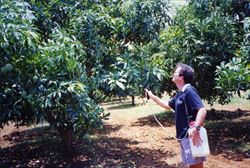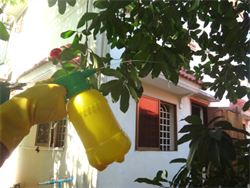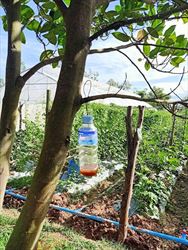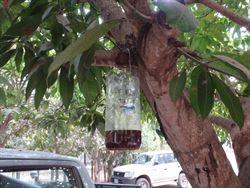COMMERCIAL BAIT SPRAYS
Bait sprays attract male and female fruit flies. They are high in protein extracted from yeast, often referred to as 'yeast autolyzate', and mostly the contents of the yeast cells without cell walls. Newly emerged adult female fruit flies are attracted to protein as they need it to produce fertile eggs. Lure and kill products combine the protein component of yeast with an insecticide, sometimes adding sugars and a thickening agent, to increase the time that the bait is retained by foliage.
Guar gum or xanthium gum are added to foods so that they become thicker and are more stable (that is they don't break down) at normal temperatures. When the other parts of the spray are added this results in a gel that remains attractive to fruit flies for longer than water-only spots. Under humid conditions it can absorb water so that the bait is still attractive.
In recent years, in Southeast Asia and the Pacific, yeast extracts have come to dominate the market in protein baits for attracting fruit flies. Yeast waste from brewing is treated with enzymes to obtain the autolysate. A process that is less toxic to foliage than previous preparations using acid extraction.
As in traps used for monitoring, malathion was used extensively in bait sprays to kill the fruit flies, but are now being replaced by the spinosad, spinetoram or fipronil.
The protein baits used in bait sprays are also replacing cover sprays. This is for two reasons: they are cheaper, using approximately 15 times less insecticide, and less toxic to user and environment. Protein bait spot-spraying is effective in reducing fruit damage by a factor of 10 and leaves none or very little residue on fruits. Apart from cost, many poorer economies have a difficulty in accessing the ingredients.
Example 1 - Protein bait spot-spraying
Products are available that contain all the ingredients necessary to attract and kill fruit flies, and these are simply added to water in a hand-held or hydraulic knapsack sprayer at the dilution rate stated on the label. An example of this pre-mixed kind of bait is Eco-Naturelure Fruit Fly Bait (https://www.ecoorganicgarden.com.au/products/pest-disease/eco-naturalure/). It combines specific food attractants (for fruit flies) with the stomach poison insecticide, spinosad. It is reported to control Queensland and Mediterranean fruit flies, but is effective on all tephritid species.
Example 2 - Bait spray
Another is Yates' Nature's Way that attracts and kills common fruit fly species. It is a protein and sugar-based bait plus spinosad (https://www.yates.com.au/product/garden-pest-control/yates-200ml-natures-way-vegie-herb-spray-concentrate/). It is applied as follows:
- 40mL Yates' Nature's Way mix with 260mL water
- Apply as a band or spot spray to the underside of lower leaves and the tree trunk (usually 2-3 spots per large tree, and every second tree); OR
- Apply every 2-3m to rows of low-growing fruit vegetables, e.g., chilli, eggplant, watermelon. Depending on the crop type treat alternative rows.
- Repeat weekly; re-apply after heavy rain.
Example 3 - Bait spray (Southeast Asia)
In another kind of spray, the protein component is bought, and other ingredients are supplied by the user. For example, the Plant Protection Research Institute, Vietnam, manufactures a protein product (EntoPro 1500DD), to which other ingredients are added, as follows:
- 100mL EntoPro in 1L water
- 0.8-1.0mL spinetoram (formulation of 120g/L) - measured by syringe, OR
- 0.2-0.4mL spinosad (formulation of 120g/L), OR
- 0.2-0.4mL fipronil (formulation of 200g/L, OR
- 4mL malathion (formulation of 500g/L)
- 5-6g guar gum (about one teaspoonful) (optional)
Place ingredients in a 1-2L hand-held sprayer, shake, and wait 10 min until ingredients have thickened to a gel.:
- Apply as a stream (NOT as a spray), i.e., with the nozzle fully open
- Apply 20-30mL in small 'spots' onto the sides of plants or under their leaves
- Apply in the morning (8-10am), the time when fruit flies are active in the crop
- Apply a spot to every 2-3m row
- Also, apply on outside rows
Example 4 - Bait sprays (Separate components - Oceania)
In the Pacific islands, Mauri Pinnacle Protein Lure (MPPIL) from Queensland, Australia, is often used. It contains 420g/L protein.
The label suggests that the product can be used on a range of horticultural crops as follows. But note, it also says that "The bait mixture may cause fruit burn in some sensitive crops, especially mangoes. Avoid contact with fruit. If unsure, test on a small area first. Use of the lower rate of protein in sensitive crops".
- 10-20mL MPPIL
- 4.4mL malathion (1150g/L), OR
- 0.25mL abamectin
- 1L water
- 5-6g guar gum or xanthum gum (about one teaspoonful) (optional)
Use the higher rate for MIPPL for low growing vegetables (e.g., watermelon) as application of the spray to the underside of the leaves is difficult. Not only is that where the flies rest, but it is where the spray has protection from sunlight and rainfall which can cause loss of its effectiveness.
For Examples 1-4, start after fruit set and continue until 3 days before harvest if using malathion, and 7 days before harvest if using abamectin. Spinosad has zero days witholding period.
SMALLHOLDER HOME-MADE TRAPS
Example 5 - Liquid feeding traps
Home-made traps can be easily assembled, although they might not be as effective as made-to-purpose commercial varieties. They can be made from plastic soft drink or water bottles or even milk or juice cartons.
- Remove the label, make holes in the shoulder of the bottle or top third of the carton (three to four holes), so that a little finger can pass through. (Large holes may lead to drying of the mixture or dilution by rain, and that will reduce the attractiveness that relies on a strong smell.)
- Fill each bottle or carton (150-200ml) or about one quarter full with a mixture made as follows:
- 1L water
- 50mL cloudy ammonia (household ammonia)
- 1tbsp sugar
- 5mL vanilla essence (artificial)
- 1tbsp yeast extract (e.g., Vegemite®, or Marmite® made from yeast extract)
- A few drops of unscented dish-washing liquid (detergent) to break the surface tension so that the flies will drown.
- Clean containers and replace contents weekly (contents will become contaminated or dry up)
- Hang (two or three containers per tree) with wire tied to the bottle top in a shady part of the tree, or onto the trellis of climbing crops, 1.5-2m above ground, 3-4m apart.
Example 6 - Liquid feeding trap with Vegemite®
This recipe relies on the strong smell of Vegemite® (a yeast extract) to attract tephritid fruit flies. Trap contents are 150-200ml of water mixed with:
- 1tsp of Vegemite® or Marmite®
- 1tsp of sugar
- 2-3 drops of non-scented liquid detergent to break the water’s surface tension (so that flies drown)
Example 7 - Liquid feeding trap with protein bait
This recipe relies on the strong smell of protein bait (yeast extract) to attract tephritid fruit flies. Trap contents are 100-150ml of the following:
- Protein bait mixture as in Example 3 and/or Example 4.
Example 8 - Liquid feeding trap with fruit pulp
This recipe relies on the smell of host fruit to attract tephritid fruit flies. The key is to get a concentration of each type of fruit that attracts the fruit flies, while the bait is liquid enough to drown them.
- Blend host fruit pulp with 1L water, and add to 600mL or 1.25mL plastic bottles with holes.
For liquid feeding traps, place traps in the crops or in the fruiting trees well before fruit set (to remove any resident populations) and continue trapping until the end of harvest.
____________________
When using a pesticide, always wear protective clothing and follow the instructions on the product label, such as dosage, timing of application, and pre-harvest interval. Recommendations will vary with the crop and system of cultivation. Expert advice on the most appropriate pesticides to use should always be sought from local agricultural authorities.










